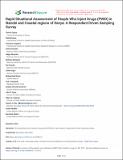| dc.contributor.author | 33. Gabriel O Dida, Francis Oguya , Francisca Ongecha, Patrick Mureithi , Helgar Musyoka, Nicholas Muraguri , Ben Mundia , Caleb Angira, Mohammed Shose, Taib A. Basheeb , Abdalla Ahmed Mohamed, , John P. Oyore , Otieno G. Ochieng , Saade Abdalla, Reychard Abdool | |
| dc.date.accessioned | 2022-01-28T06:08:31Z | |
| dc.date.available | 2022-01-28T06:08:31Z | |
| dc.date.issued | 2020 | |
| dc.identifier.uri | https://repository.maseno.ac.ke/handle/123456789/4707 | |
| dc.description.abstract | Background:
A Cross-sectional Rapid Situational Assessment of People Who Inject Drug (PWIDs) applying Respondent Driven sampling techniques (RDS)
was used to recruit subjects/participants in a study aimed at assessing HIV prevalence and risk behaviors among injection drug users in Nairobi
and Coastal region of Kenya. There is paucity of data and information on injecting drug use in sub-Saharan Africa and there is sufficient
evidence of existence of the environment for development and growth of injecting drug use. Past studies on PWID and its association to HIV
and AIDS that have been conducted in Kenya do not provide sufficient information to support effective planning and comprehensive national
response to the HIV and AIDS epidemic.
Methods: A cross-sectional study design was adopted in which a set of initial subjects referred to as ‘seeds’ were first identified from which an
expanding chain of referrals were obtained, with subjects from each wave referring subjects of subsequent wave. The seeds were drawn
randomly from the population and interviewed to pick the one with the largest network and other unique characteristics. A maximum of twelve
seeds were recruited. The second stage involved conducting assessment visits to the sites to identify potential collaborators that included non governmental organizations (NGOs), drug treatment centres, health facilities, Community based organizations (CBO's) among others. Three
NGOs located in the coast region and one in Nairobi region were identified to assist in identifying drug injection locations and potential
participants. Key informant interviews (KIIs) and Focus Group Discussions (FGDs) were also conducted using interview guides.
Results: A total of 646 individuals (344 in Nairobi and 302 at the coast) were recruited for the study between January and March 2010. Of these
590 (91%) were male and 56 (9%) were female. Findings showed that most PWIDs initiated injecting drug use between the ages of 20-29 years,
with the youngest age of initiation being 11 years and oldest age being 53 years. Most commonly injected drug was heroin (98%), with a small
(2%) percentage injecting cocaine. Other non-injecting methods such as smoking or combining these two drugs with other drugs such as
cannabis or Rohypnol were also common. Most PWIDs used other substances (cigarettes, alcohol, and cannabis) before initiating injecting drug
use. HIV prevalence of PWIDs in Nairobi was (24.4% unadjusted) compared to their counterparts residing in the Coastal region (18.5% -
unadjusted). The age specific HIV prevalence showed that PWIDs who initiated injecting at 11-19 years (44.7% adjusted) were most at risk in
Nairobi compared to those who initiated injecting at age 20-24 years (23.2% - adjusted) in the coastal region. While all PWIDs continue to be at
risk in the two regions, those from the Western parts of Nairobi were at a relatively higher risk given their increased propensity for sharing
injecting equipment and solutions.
Conclusions: Compared to the national HIV prevalence of (4.9%), the results show that People Who Inject Drugs (PWIDs) are at particularly high
risk of infection in Kenya and there is urgent need for intervention (KenPHIA, 2018). This study also showed clear evidence that PWIDs engage in
high risky injecting and sexual behaviors comprising sharing of injecting equipment, unprotected heterosexual and homosexual sex. Given that
initiation of injection drug use begins early and peaks after formal school years (20-29 years), prevention programmes should be targeted at
secondary school, college and out of school youth. Further, to protect People who inject drugs (PWIDs) from HIV infection, the country should
introduce free Needle Syringe Programs with provision of condoms and Methadone Assisted Therapy (MAT) as a substitute for drug use. | en_US |
| dc.publisher | Research Gate | en_US |
| dc.subject | HIV-related behaviors, Injection drug users (PWIDs), Coast, Nairobi, Respondent Driven Sampling, Kenya | en_US |
| dc.title | Rapid Situational Assessment of People Who Inject Drugs (PWID) in Nairobi and Coastal regions of Kenya: A Respondent Driven Sampling Survey | en_US |
| dc.type | Article | en_US |

